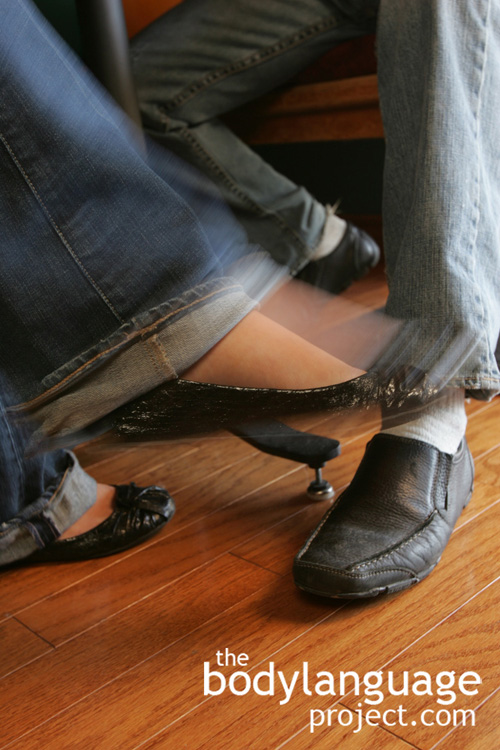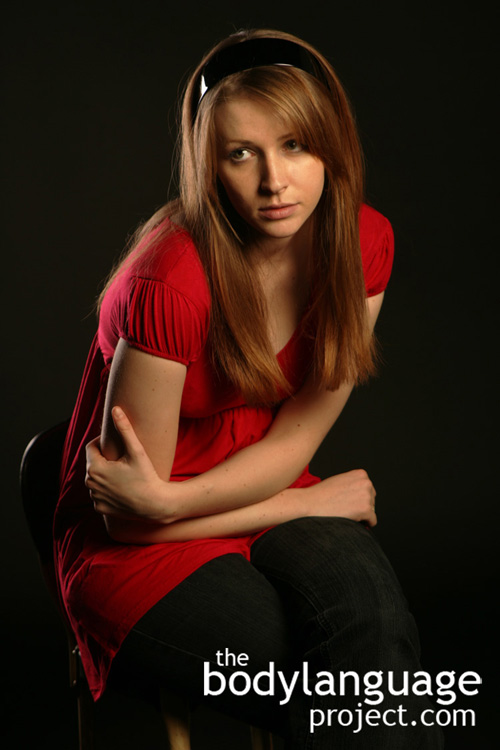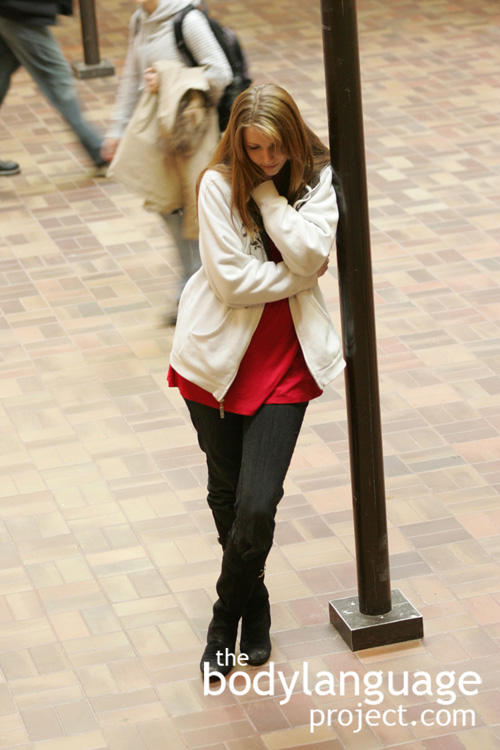Body Language of The Figure Four Leg Clamp or Figure Four Leg Lock
 Cue: Figure Four Leg Clamp or Figure Four Leg Lock
Cue: Figure Four Leg Clamp or Figure Four Leg Lock
Synonym(s): Leg Clamp
Description: The figure four leg clamp is similar to the regular figure four leg cross where the ankle is pulled over the knee of the opposite leg forming the figure four position, except in this case, the arm grabs the ankle to lock it in place.
In One Sentence: The figure four leg clamp is a dominance display coupled with a locked leg indicating a rigid attitude.
How To Use it: Use the figure four to demonstrate dominance and lock your posture in place with your hand to show that you are a fortress that protects your own unique ideals. This posture is generally ill-advised, but can find its place when there is a struggle for power and you feel that your judgment is superior.
Context: General.
Verbal Translation: “I’m dominant so I’m crossing my legs to expose my genitals, but I’m also stubborn so I’m making a barrier with my forearm and locking this in place to show you just how serious I am about my opinions.”
Variant: See Figure Four Seating Position (The) or The Ankle-Knee Cross.
Cue In Action: The salesman knew he wasn’t getting anywhere with the client as soon as his client’s body language changed from the European leg cross to the figure four leg cross with his arm locking the cross in place. When he began the pitch, his posture as open, he was leaning in and asking questions, but when the final bill came due, he leaned back and crossed his ankle over his knee. When the taxes where added, he grabbed his ankle and scowled. It was clear that major roadblocks would have to be overcome if they were to sign a deal.
Meaning and/or Motivation: The figure four seating position can be closed off entirely by placing each hand on the shin so as to lock the leg in place. This posture indicates that someone is extremely stubborn and most likely apt to reject opinions of others.
The leg locker is also highly opinionated in most every way and may lead you into disagreement at every turn. If selling an idea or product, it might be best to drop the pitch altogether and seek more agreeable company unless you are comfortable using extreme tact, or are skilled at building relationships quickly.
Cue Cluster: The figure four hand lock is often coupled with negative facial expressions, scowls, or frowns.
Body Language Category: Amplifier, Barriers, Body cross, Blocking or Shielding, Clenching and gripping, Closed body language, Crotch display, Defensive, Dislike (nonverbal), Doubt or disbelief body language, Negative body language.
Resources:
Allen, Jill; Sarah J. Gervais and Jessi L. Smith. Sit Big to Eat Big: The Interaction of Body Posture and Body Concern on Restrained Eating. Psychology of Women Quarterly 2013. 37(3): 325-336. DOI: 10.1177/0361684313476477pwq.sagepub.com
http://bodylanguageproject.com/articles/sit-big-to-eat-big-how-constrictive-postures-reduce-food-consumption/
Arnette, S. L., & Pettijohn, T. F., II. (2012). The effects of posture on self-perceived leadership. International Journal of Business and Social Science, 3, 8–13.
Bohns, Vanessa K. and Scott S. Wiltermuth. It Hurts When I Do This (Or You Do That): Posture And Pain tolerance. Journal of Experimental Social Psychology. 2012. 48: 341-345.
http://bodylanguageproject.com/articles/dominant-and-submissive-postures-affects-more-than-public-perception-it-also-affects-felt-pain-and-physical-strength/
Briñol, P., Petty, R. E., & Wagner, B. (2009). Body posture effects on self-evaluation: A self-validation approach. European Journal of Social Psychology, 39, 1053–1064.
Balzarotti, Stefania ; Piccini, Luca ; Andreoni, Giuseppe ; Ciceri, Rita “I Know That You Know How I Feel”: Behavioral and Physiological Signals Demonstrate Emotional Attunement While Interacting with a Computer Simulating Emotional Intelligence. Journal of Nonverbal Behavior. 2014. 38(3): 283-299.
Bartholomewn, Morgan E.; Sheri L. Johnson. Nonverbal Dominance Behavior Among Individuals at Risk for Mania. Journal of Affective Disorders. 2014. 159: 133-138.
Burgoon, J. K., Johnson, M. L., & Koch, P. T. (1998). The nature and measurement of interpersonal dominance. Communication Monographs, 65, 308–335.
Cashdan, Elizabeth. Smiles, Speech, and Body Posture: How Women and Men Display Sociometric Status and Power. Journal of Nonverbal Behavior. 1998. 22(4): 209-228.
Carney, D. R., Hall, J. A., & LeBeau, L. S. (2005). Beliefs about the nonverbal expression of social power. Journal of Nonverbal Behavior, 29, 105–123.
Chance RMA (1962) An interpretation of some agonistic postures: the role of “cut-off” acts and postures. Symp Zool Soc Lond 8: 71–89.
Carney, Dana R.; Amy J.C. Cuddy; Andy J. Yap. Power Posing: Brief Nonverbal Displays Affect Neuroendocrine Levels and Risk Tolerance. Psychological Science, 2010; 21 (10): 1363-1368. http://bodylanguageproject.com/articles/benefits-power-posing-high-stakes-performance/
Cuddy, Amy J.C., Caroline A. Wilmuth, and Dana R. Carney. The Benefit of Power Posing Before a High-Stakes Social Evaluation. Harvard Business School Working Paper, No. 13-027, September 2012.
http://bodylanguageproject.com/articles/benefits-power-posing-high-stakes-performance/
Cesario, J., & McDonald, M. M. (2013). Bodies in context: Power poses as a computation of action possibility. Social Cognition, 31, 260–274.
de Lemus, Soledad; Russell Spears and and Miguel Moya. The Power of a Smile to Move You: Complementary Submissiveness in Women’s Posture as a Function of Gender Salience and Facial Expression. Personality and Social Psychology Bulletin. 2012. 38(11): 1480-1494.
Fischer, Julia; Peter Fischer; Birte Englich; Nilüfer Aydin and Dieter Frey. Empower My Decisions: The Effects of Power Gestures on Confirmatory Information Processing. Journal of Experimental Social Psychology. 2011. 47: 1146-1154.
http://bodylanguageproject.com/articles/downside-power-posing-body-language-looking-power-posing-action-study/
Carney, Dana R.; Amy J.C. Cuddy; Andy J. Yap. Power Posing: Brief Nonverbal Displays Affect Neuroendocrine Levels and Risk Tolerance. Psychological Science, 2010; 21 (10): 1363-1368.
Gifford, Robert ; O’Connor, Brian. Nonverbal intimacy: Clarifying the role of seating distance and orientation. Journal of Nonverbal Behavior. 1986 10(4): 207-214.
Gorkan Ahmetoglu, Viren Swami. Do Women Prefer “Nice Guys?” The Effect Of Male Dominance Behavior On Women’s Ratings. Social Behavior And Personality, 2012; 40(4), 667-672.
http://bodylanguageproject.com/articles/how-to-significantly-increase-male-attractiveness-with-simple-body-language-nice-guys-finish-last-once-again/
Gunderson, Virginia M. ; Lockard, Joan S. Human postural signals as intention movements to depart: African data. Animal Behaviour. 1980 28(3): 966-967.
Huang, L., Galinsky, A. D., Gruenfeld, D. H., & Guillory, L. E. (2011). Powerful postures versus powerful roles: Which is the proximate correlate of thought and behavior? Psychological Science, 22, 95–102.
Harrigan, Jinni ; Oxman, Thomas ; Rosenthal, Robert. Rapport expressed through nonverbal behavior. Journal of Nonverbal Behavior. 1985 9(2): 95-110.
Lockard, J.S. ; Allen, D.J. ; Schiele, B.J. ; Wiemer, M.J. Human postural signals: Stance, weight-shifts and social distance as intention movements to depart. Animal Behaviour. 1978 26: 219-224.
LaFrance, M. (1979). Nonverbal synchrony and rapport: Analysis by the cross-lag panel technique. Social Psychology Quarterly, 42, 66-70.
LaFrance, M. (1982). Posture mirroring and rapport. In M. Davis (Ed.), Interaction
rhythms: Periodicity in communicative behavior (pp. 279-298).New York: Human Sciences Press.
LaFrance, M., & Broadbent, M. (1976). Group rapport: Posture sharing as a nonverbal indicator. Group and Organization Studies, 1, 328-333.
Locke, Connson C. and Cameron Anderson. The Downside of Looking Like a Leader: Leader’s Powerful Demeanor Stifles Follower Voice in Participative Decision-Making.. Academy of Management Annual Meeting Proceedings. 2010. 8(1): 1-6.
http://bodylanguageproject.com/articles/power-body-language-goes-far/
Laird, J. D., & Lacasse, K. (2014). Bodily influences on emotional feelings: Accumulating evidence and extensions of William James’s theory of emotion. Emotion Review, 6, 27–34.
Lee, E. H., & Schnall, S. (2014). The influence of social power on weight perception. Journal of Experimental Psychology: General, 143, 1719–1725.
Michalak, J., Mischnat, J., & Teismann, T. (2014). Sitting posture makes a difference: Embodiment effects on depressive memory bias. Clinical Psychology & Psychotherapy, 21, 519–524.
Minvaleev, R. S., Nozdrachev, A. D., Kir’yanova, V. V., & Ivanov, A. I. (2004). Postural influences on the hormone level in healthy subjects: I. The cobra posture and steroid hormones. Human Physiology, 30, 452–456.
Michael Reiβ. Leg-crossing: Incidence and inheritance. Neuropsychologia. 1994. 32(6): 747-750.
Marsh, Abigail A; Henry H. Yu; Julia C. Schechter and R. J. R. Blair. Larger than Life: Humans’ Nonverbal Status Cues Alter Perceived Size. PLoS ONE. 2009. 4(5): e5707. doi:10.1371/journal.pone.0005707. http://bodylanguageproject.com/articles/large-life-nonverbal-dominance-affects-perception-size/
Mehrabian, A. (1968) Inference of attitudes from the posture, orientation, and distance of a communicator. Journal of Consulting and Clinical Psychology, 32, 296–308.
Mehrabian, A. (1969). Significance of posture and position in the communication of attitude and status relationship. Psychological Bulletin, 71, 359–372.
Meier, B.P., Robinson, M.D., & Caven, A.J. (in press). Why a big mac is a good mac: Associations between affect and size. Basic and Applied Social Psychology.
Matsumura, Shuichi ; Hayden, Thomas J. When should signals of submission be given?–A game theory model. Journal of Theoretical Biology. 2006. 240(3): 425-433.
Mehrabian, Albert Holzberg, Jules D. (editor). Inference of Attitudes From the Posture, Orientation and Distance of a Communicator. Journal of Consulting and Clinical Psychology. 1968. 32(3): 296-308.
Mehrabian, Albert Deese, James (editor). Significance of posture and position in the communication of attitude and status relationships. Psychological Bulletin. 1969. 71(5): 359-372.
Matsumoto, D., & Willingham, B. (2006). The thrill of victory and the agony of defeat: Spontaneous expressions of medal winners of the 2004 Athens Olympic Games. Journal of Personality and Social Psychology, 91(3), 568–581.
Mouterde, S. C., Duganzich, D. M., Molles, L. E., Helps, S., Helps, R., & Waas, J. R. (2012). Triumph displays inform eavesdropping little blue penguins of new dominance asymmetries. Animal Behaviour, 83, 605–611.
Nair, S., Sagar, M., Sollers, J., III, Consedine, N., & Broadbent, E. (2014). Do slumped and upright postures affect stress responses? A randomized trial. Health Psychology. Advance online publication. doi:10.1037/hea0000146
Navarro, Joe. 2008. What Every BODY is Saying: An Ex-FBI Agent’s Guide to Speed-Reading People. William Morrow Paperbacks.
Pitterman, Hallee ; Nowicki Jr, Stephen. A Test of the Ability to Identify Emotion in Human Standing and Sitting Postures: The Diagnostic Analysis of Nonverbal Accuracy-2 Posture Test (DANVA2-POS). Genetic, Social, and General Psychology Monographs. 2004. 130(2): 146-162.
Park, Lora E.; Lindsey Streamer; Li Huang and Adam D. Galinsky. Stand Tall, But Don’t Put Your Feet Up: Universal and Culturally-Specific Effects of Expansive Postures On Power. Journal of Experimental Social Psychology. 2013; 49: 965–971.
http://bodylanguageproject.com/articles/are-expansive-postures-of-power-universal-or-cultural/
Pease, Barbara and Allan Pease. 2006. The Definitive Book of Body Language Hardcover. Bantam.
Pinar, Rukiye ; Ataalkin, Sıddıka ; Watson, Roger. The effect of crossing legs on blood pressure in hypertensive patients. Journal of Clinical Nursing. 2010. 19(9-10): 1284-1288.
Park, Yongnam ; Bae, Youngsook. Comparison of Postures According to Sitting Time with the Leg Crossed. Journal of Physical Therapy Science. 2014. 26(11): 1749-1752.
Peters. M. Footedness: asymmetries in foot preference and skill and neuropsychological assessment of foot movement. Psycho/. Bull. 103, 179 192, 1988.
Plato. C. C., Fox, K. M. and Gakruto, R. M. Measures of lateral functional dominance: Foot preference. digital interlocking, arm-folding and fool overlapping. Human Biology. 1985. 57: 327-334.
Riskind, J. H., & Gotay, C. C. (1982). Physical posture: Could it have regulatory or feedback effects upon motivation and emotion? Motivation and Emotion, 6, 273–296.
Reiss M. Leg-crossing: incidence and inheritance. Neuropsychologia. 1994. 32(6):747-50.
Ranehill, Eva; Anna Dreber; Magnus Johannesson; Susanne Leiberg; Sunhae Sul and Roberto A. Weber. Assessing the Robustness of Power Posing: No Effect on Hormones and Risk Tolerance in a Large Sample of Men and Women. Psychological Science, March, 2015. doi: 10.1177/0956797614553946
http://bodylanguageproject.com/articles/power-posing-no-effect-hormones-amy-cuddy-wrong/
Riskind, J. H. (1984). They stoop to conquer: Guiding and selfregulatory functions of physical posture after success and failure. Journal of Personality and Social Psychology, 47, 479–493.
Riskind, J. H., & Gotay, C. C. (1982). Physical posture: Could it have regulatory or feedback effects on motivation and emotion? Motivation and Emotion, 6, 273–298.
Roberts, Tomi-Ann and Yousef Arefi-Afshar. Not All Who Stand Tall Are Proud: Gender Differences in the Proprioceptive Effects of Upright Posture. Cognition and Emtion. 2007. 21(4):714-727.
http://bodylanguageproject.com/articles/do-women-benefit-from-power-posing-study-suggests-not/
Sturman, Edward D. Invluntary Subordination and Its Relation to Personality, Mood,
and Submissive Behavior. Psychological Assessment. 2011. 23(1): 262-276 DOI: 10.1037/a0021499
http://bodylanguageproject.com/articles/nonverbal-submission-men-women-depression-critical-examination-use-disuse-submission/
Stanton, Steven J. and Robin S. Edelstein. The Physiology of Women’s Power Motive: Implicit Power Motivation is Positively Associated With Estradiol Levels in Women. Journal of Research in Personality. 2009. 43: 1109-1113.
http://bodylanguageproject.com/articles/the-estrogen-factor-the-search-for-nonverbal-power-in-women/
Stanton, Steven J. The Essential Implications of Gender in Human Behavioral Endocrinology Studies. Frontiers in Behavioral Neuroscience. 2011. 5(9): 1-3. doi: 10.3389/fnbeh.2011.00009
http://bodylanguageproject.com/articles/a-critical-commentary-on-amy-cuddys-power-posing/
Sartori, Luisa ; Becchio, Cristina ; Castiello, Umberto. Cues to Intention: The Role of Movement Information. Cognition. 2011. 119(2): 242-252.
Schwartz, B., Tesser, A., & Powell, E. (1982). Dominance cues in nonverbal behavior. Social Psychology Quarterly, 45, 114–120.
Stepper, S., & Strack, F. (1993). Proprioceptive determinants of emotional and nonemotional feelings. Journal of Personality and Social Psychology, 64, 211–220.
Strelan, P., Weick, M., & Vasiljevic, M. (2013). Power and revenge. British Journal of Social Psychology, 53, 521–540.
Tamir, M., Robinson, M. D., Clore, G. L., Martin, L. L., & Whitaker, D. J. (2004). Are we puppets on a string? The contextual meaning of unconscious expressive cues. Personality and Social Psychology Bulletin, 30, 237–249.
Tiedens, Larissa Z. and Alison R. Fragale. Power Moves: Complementarity in Dominant and Submissive Nonverbal Behavior. Journal of Personality and Social Psychology. 2003, 84(3): 558–568.
http://bodylanguageproject.com/articles/power-posing-no-effect-hormones-amy-cuddy-wrong/
Tracy, J. L., & Robins, R. W. (2004). Show your pride: Evidence for a discrete emotion expression. Psychological Science, 15, 194–197.
Van Velthoven, Michelle H M M T ; Thien, Theo ; Holewijn, Suzanne ; Van Der Wilt, Gert Jan ; Deinum, Jaap. The effect of crossing legs on blood pressure. Journal of hypertension. 2010. 28(7): 1591-2.
Welker, Keith M. ; Oberleitner, David E. ; Cain, Samantha ; Carré, Justin M. Upright and left out: Posture moderates the effects of social exclusion on mood and threats to basic needs. European Journal of Social Psychology. 2013 43(5): 355-361
Yap, Andy J. Abbie S. Wazlawek, Brian J. Lucas, Amy J. C. Cuddy, Dana R. Carney. The Ergonomics of Dishonesty: The Effect of Incidental Posture on Stealing, Cheating, and Traffic Violations, 24(11); 2281-2289.
http://bodylanguageproject.com/articles/body-posture-physical-environment-determine-feelings-and-behaviour-study/








